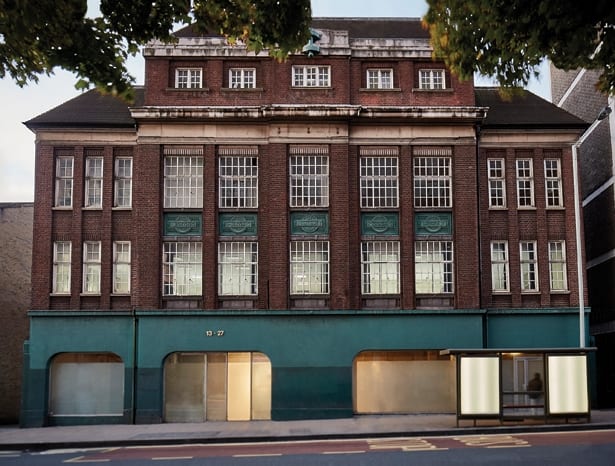 The 1930s electric company’s facade has been retained|||
The 1930s electric company’s facade has been retained|||
Wood Green is hardly the most salubrious part of town and I write that as a nearby resident with a fondness for this patch of north London. So it’s all the more heartening that the Green Rooms, a newly opened hotel in the area, has already been given a design commendation by New London Architecture for this not-for-profit venture.
Young practice SODA, which has some pretty cool clients under its belt – Soho House, the Polpo Group and everyone’s favourite ramen noodles joint Bone Daddies – was commissioned to work its magic on this art deco building, just off a busy, inauspicious road junction near the Tube.
 Vintage furniture and accessories create the mood for the lounge
Vintage furniture and accessories create the mood for the lounge
SODA’s founding director Laura Sanjuan sums up the scheme as “original details combined with a stripped-back contemporary aesthetic”. My tour begins in the cafe, bar and restaurant space at the front of the ground floor. It’s furnished with all the mid-century goodness we’ve become used to in the hospitality sector but this is more authentic than most.
A 2m tall oak cabinet sets the tone for the dining area, with matching oak and leather library table. At the other end is a second, smaller oak bookcase containing vintage Penguin books. The lounge area displays two custom-made leather Classic sofas from Davison Highley – a design created by Barry Davison in 1977 – and cushions featuring original prints from Ercol.
 Davison Highley Classic sofas offset the original parquet
Davison Highley Classic sofas offset the original parquet
The furniture was selected by Green Rooms chairman Kurt Bredenbeck, the man behind the Hoxton Hotel, who joined forces with Nick Hartwright of the Mill Co to realise the concept of affordable accommodation for actors and those working in the arts. Hartwright is no stranger to skilfully devised social enterprises, Mill Co being involved with Mandarin Wharf and the Rose Lipman Building in Hackney, and Gaunson House in Tottenham.
Originally the building was home to the North Metropolitan Electric Power Supply Company, where the great and the good bought their white goods in the 1930s. What was once a warehouse out back has been transformed into dormitory accommodation with a generous application of cheap and cheerful chipboard and decent quality mattresses. There are also two long-stay apartments – the artist’s studio I was shown had its own mezzanine level via a stepladder.
 The hotel lobby opens directly to the street
The hotel lobby opens directly to the street
Floors one and two feature 22 private bedrooms, continuing the blue, brown and cream accent colours found downstairs. It’s no-frills but characterful, and, as well as a healthy dose of vintage finds, some lucky visitors will get to experience furniture by fashion label Folk. Continues Sanjuan: “We juxtaposed clean, modern lines and expressed services with retained fragments of original marble, ceiling features and exposed blockwork.”
This can be seen in the corridors on the ground floor, while a peek in the communal bathrooms reveals some gorgeous mosaic tiling: the blue duotone geometric border is offset against a softer, scalloped tile design used for the main floor.
 Bedrooms mix original post-war and bespoke pieces
Bedrooms mix original post-war and bespoke pieces
On the third floor is the pièce de résistance as far as original architectural features goes: a stunning skylight. One of the many elements hidden by a series of temporary walls and hung ceilings, it has a central circular porthole, finished in patterned Flemish glass.
Large enough for live music, talks, exhibitions, meetings – even weddings – this space fulfils the project’s need to serve the community. Supported by the mayor of London’s High Street Fund, this is a beautifully restored property with a unique purpose that adds something to its surroundings in the way that your usual chain could never do.
A London hotel for actors and artists delivers authentic vintage style and a cool pared-back aesthetic on a not-for-profit budget

























